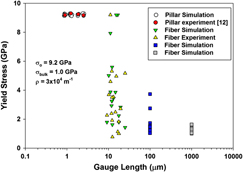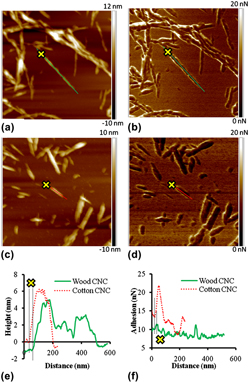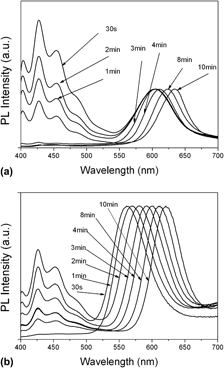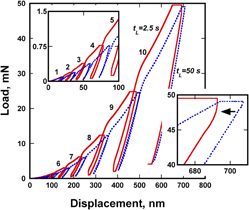Refine search
Actions for selected content:
106102 results in Materials Science
Electrochemical and ex-situ analysis on manganese oxide/graphene hybrid anode for lithium rechargeable batteries
-
- Journal:
- Journal of Materials Research / Volume 26 / Issue 20 / 28 October 2011
- Published online by Cambridge University Press:
- 23 September 2011, pp. 2665-2671
- Print publication:
- 28 October 2011
-
- Article
- Export citation
Evolution of the Sn/Ni–8.0 at.%V interfacial reaction paths
-
- Journal:
- Journal of Materials Research / Volume 26 / Issue 22 / 28 November 2011
- Published online by Cambridge University Press:
- 23 September 2011, pp. 2838-2843
- Print publication:
- 28 November 2011
-
- Article
- Export citation
Rotation field in wedge indentation of metals
-
- Journal:
- Journal of Materials Research / Volume 27 / Issue 1 / 14 January 2012
- Published online by Cambridge University Press:
- 23 September 2011, pp. 284-293
- Print publication:
- 14 January 2012
-
- Article
- Export citation
Strip twisted electrospun nanofiber yarns: Structural effects on tensile properties
-
- Journal:
- Journal of Materials Research / Volume 27 / Issue 3 / 14 February 2012
- Published online by Cambridge University Press:
- 23 September 2011, pp. 537-544
- Print publication:
- 14 February 2012
-
- Article
- Export citation
Stored elastic energy influence on the elastic–plastic transition of GaAs structures
-
- Journal:
- Journal of Materials Research / Volume 27 / Issue 1 / 14 January 2012
- Published online by Cambridge University Press:
- 23 September 2011, pp. 177-181
- Print publication:
- 14 January 2012
-
- Article
- Export citation
Solvothermal synthesis of a highly branched Ta-doped TiO2
-
- Journal:
- Journal of Materials Research / Volume 26 / Issue 20 / 28 October 2011
- Published online by Cambridge University Press:
- 23 September 2011, pp. 2653-2659
- Print publication:
- 28 October 2011
-
- Article
- Export citation
In-situ tensile testing of single-crystal molybdenum-alloy fibers with various dislocation densities in a scanning electron microscope
-
- Journal:
- Journal of Materials Research / Volume 27 / Issue 3 / 14 February 2012
- Published online by Cambridge University Press:
- 23 September 2011, pp. 508-520
- Print publication:
- 14 February 2012
-
- Article
- Export citation
Measurements of mechanical properties of α-phase in Cu–Sn alloys by using instrumented nanoindentation
-
- Journal:
- Journal of Materials Research / Volume 27 / Issue 1 / 14 January 2012
- Published online by Cambridge University Press:
- 23 September 2011, pp. 192-196
- Print publication:
- 14 January 2012
-
- Article
- Export citation
Size effects on the nanomechanical properties of cellulose I nanocrystals
-
- Journal:
- Journal of Materials Research / Volume 27 / Issue 3 / 14 February 2012
- Published online by Cambridge University Press:
- 23 September 2011, pp. 528-536
- Print publication:
- 14 February 2012
-
- Article
- Export citation
Characterization of homogenous and plastically graded materials with spherical indentation and inverse analysis
-
- Journal:
- Journal of Materials Research / Volume 27 / Issue 1 / 14 January 2012
- Published online by Cambridge University Press:
- 23 September 2011, pp. 20-27
- Print publication:
- 14 January 2012
-
- Article
- Export citation
Manganese-doped MnSe/CdSe core/shell nanocrystals: Preparation, characterization, and study of growth mechanism
-
- Journal:
- Journal of Materials Research / Volume 26 / Issue 18 / 28 September 2011
- Published online by Cambridge University Press:
- 21 September 2011, pp. 2400-2406
- Print publication:
- 28 September 2011
-
- Article
- Export citation
Solid-state pyrolysis of iron phthalocyanine polymer into iron nanowire inside carbon nanotube and their novel electromagnetic properties
-
- Journal:
- Journal of Materials Research / Volume 26 / Issue 18 / 28 September 2011
- Published online by Cambridge University Press:
- 21 September 2011, pp. 2369-2372
- Print publication:
- 28 September 2011
-
- Article
- Export citation
Zn2+–Eu3+ energy transfer and calculation of Eu3+ 5D0 quantum efficiency
-
- Journal:
- Journal of Materials Research / Volume 26 / Issue 18 / 28 September 2011
- Published online by Cambridge University Press:
- 20 September 2011, pp. 2407-2413
- Print publication:
- 28 September 2011
-
- Article
- Export citation
Nanoimprinted complementary organic electronics: Single transistors and inverters
-
- Journal:
- Journal of Materials Research / Volume 26 / Issue 19 / 14 October 2011
- Published online by Cambridge University Press:
- 20 September 2011, pp. 2470-2478
- Print publication:
- 14 October 2011
-
- Article
- Export citation
Thermal expansion of Cu6Sn5 and (Cu,Ni)6Sn5
-
- Journal:
- Journal of Materials Research / Volume 26 / Issue 20 / 28 October 2011
- Published online by Cambridge University Press:
- 20 September 2011, pp. 2660-2664
- Print publication:
- 28 October 2011
-
- Article
- Export citation
Mechanical assessment of ultrafine-grained nickel by microcompression experiment and finite element simulation
-
- Journal:
- Journal of Materials Research / Volume 27 / Issue 1 / 14 January 2012
- Published online by Cambridge University Press:
- 20 September 2011, pp. 266-277
- Print publication:
- 14 January 2012
-
- Article
- Export citation
Assessment of elastic anisotropy and incipient plasticity in Fe3C by nanoindentation
-
- Journal:
- Journal of Materials Research / Volume 27 / Issue 1 / 14 January 2012
- Published online by Cambridge University Press:
- 20 September 2011, pp. 45-52
- Print publication:
- 14 January 2012
-
- Article
- Export citation
Influence of indium addition on electromigration behavior of solder joint
-
- Journal:
- Journal of Materials Research / Volume 26 / Issue 20 / 28 October 2011
- Published online by Cambridge University Press:
- 19 September 2011, pp. 2624-2631
- Print publication:
- 28 October 2011
-
- Article
- Export citation
Analyzing mechanical properties of a nanocrystalline Fe–Ni coating by nanoindentation
-
- Journal:
- Journal of Materials Research / Volume 26 / Issue 19 / 14 October 2011
- Published online by Cambridge University Press:
- 19 September 2011, pp. 2533-2542
- Print publication:
- 14 October 2011
-
- Article
- Export citation
Chemomechanical effects of long-chain alcohols during nanoindentation
-
- Journal:
- Journal of Materials Research / Volume 27 / Issue 1 / 14 January 2012
- Published online by Cambridge University Press:
- 19 September 2011, pp. 222-228
- Print publication:
- 14 January 2012
-
- Article
- Export citation




















